Research shows far-reaching costs of eviction filings to tenants – regardless of the outcome in court
Contact:
Lauren Slagter, University of Michigan, lslag@umich.edu
Zakya Hall, Community Legal Services of Philadelphia, zhall@clsphila.org
A new study from the University of Michigan documents the far-reaching costs of eviction filings for Pennsylvania tenants who had eviction cases filed against them but experienced a “best-case scenario” in court, meaning they had legal representation and their cases were dismissed, withdrawn, or won.
Eviction court filings negatively impacted the health, housing stability, and economic prosperity of tenants years beyond their court date – even when the case did not result in an eviction judgment against the tenant. In the study, tenants listed the costs and losses they experienced after an eviction filing and rated the degree of impact of the various costs and losses.

Alexa Eisenberg
“Simply being named in an eviction complaint is enough to trigger a cascade of consequences that cause lasting harm to tenants and their families,” said Alexa Eisenberg, a research fellow and lecturer at U-M’s School of Public Health. “The collateral costs of eviction filings are not inevitable. State legislators can automatically seal eviction records from public view and implement other immediate policy changes that can mitigate the harm of eviction records and support the stability and well-being of residents across the state.”
Eisenberg co-authored a report, “Record Costs: Collateral Consequences of Eviction Court Filings in Pennsylvania,” with Kate Brantley, a research area specialist at U-M’s Housing Solutions for Health Equity. The research was supported by Community Legal Services of Philadelphia and Poverty Solutions at U-M.
Landlords increasingly rely on tenant screening companies and internet searches to apply blanket denials of applicants with eviction records. Eight in 10 research participants said their eviction filing limited their future housing options and prolonged their housing instability. Among the tenants who moved after facing an eviction filing, 65% said a prospective landlord asked about their eviction record, and over half said a landlord explicitly denied the tenant’s application because of their eviction filing. Tenants pay each time they submit a rental application, so unsuccessful applications rack up excess fees.
“(W)hen we go to find new housing, we can’t because we have these (filings) on our records, and that’s wrong … I won (my) case … and it’s still following me. Why?” said one tenant in the study.

Kate Brantley
Some tenants with eviction records moved into substandard or hazardous units in order to avoid or emerge from homelessness. Participants in the study who remained in their housing were generally dissatisfied with their housing quality and endured persistent eviction threats. Most said they would move to a better housing situation if they could, yet the majority did not search and many anticipated challenges securing new housing they could afford.
“Eviction records are not merely a reflection of renters’ instability — they are also a cause of it,” Brantley said. “Punitive filing and landlord screening practices exacerbate the effects of Pennsylvania’s housing crisis, making it nearly impossible for tenants with eviction records to find safe, decent, and affordable housing for their families.”

Holly Beck
“This research shows what we hear over and over from the tenants we represent: that even when a tenant wins in court, they are routinely denied for rental housing because it’s the eviction filing itself that is reported to future landlords,” said Holly Beck, divisional supervising attorney at Community Legal Services of Philadelphia.
The researchers point to ways Pennsylvania legislators can stabilize communities and reduce the long-term costs of eviction filings, stressing the importance of passing legislation to seal eviction records – especially for cases that are dismissed, withdrawn, or won by the tenant. Currently, eviction court filings remain public record indefinitely in Pennsylvania, even when the records are incomplete or inaccurate and regardless of case outcomes.
“Because tenant screening companies can scrape eviction records as soon as the information is public, sealing at the point of filing is the most effective approach to limiting unfair tenant screening practices,“ Eisenberg said. “Landlords’ use of tenant screening not only exacerbates housing instability, it also perpetuates housing discrimination against Black women and children who are disproportionately filed against. Sealing eviction records is a housing justice priority.”
Detroiters’ perceptions of their neighborhoods shifted after Strategic Neighborhood Fund investments
The map shows the Detroit neighborhoods that received targeted infrastructure improvements through the Strategic Neighborhood Fund.
Contact: Lauren Slagter, lslag@umich.edu
DETROIT – A study drawing on survey data from the past five years shows that while neighborhood satisfaction fell across Detroit as the pandemic unfolded, neighborhoods that had received targeted infrastructure improvements proved more resilient.
The survey data reported by University of Michigan researchers showed the onset of the COVID-19 pandemic in 2020 changed Detroiters’ relationships with their neighborhoods, ushering in an overall decline in satisfaction likely linked to the closure of businesses, stay-at-home orders, the financial toll of the economic shutdown, and rising rates of infection and death.
The decline in satisfaction was most pronounced in neighborhoods that had not received $262 million in targeted infrastructure investments from the City of Detroit, Invest Detroit, and its partners as part of the Strategic Neighborhood Fund program.

Lydia Wileden
“The pandemic clearly shaped how Detroiters view their neighborhoods and challenged residents’ sense of local progress. However, our findings show that people’s sense of neighborhood change largely stalled during the pandemic rather than reversing altogether,” said Lydia Wileden, a research associate at U-M’s Detroit Metro Area Communities Study. “This means that rather than losing ground, local investments may have helped stabilize communities during that tumultuous time.”
Wileden, also a postdoctoral scholar at the University of Chicago’s Mansueto Institute for Urban Innovation, authored a series of reports on the survey data.
The later surveys – in 2022 and 2023 – document the emergence of a “new normal,” when residents’ satisfaction with their neighborhoods, change in quality of life, and perceived change in neighborhood remain mostly level.
In other areas – satisfaction with amenities like the availability of parks and playgrounds and the conditions of streets and sidewalks – resident sentiments rebounded to pre-pandemic levels. Resident perceptions showed signs of positive change related to perceived change in population and neighborhood attractiveness.
The Strategic Neighborhood Fund program is a place-based investment effort to develop dense, safe, mixed-income neighborhoods that boost economic opportunity and improve the quality of life for residents. The Strategic Neighborhood Fund is managed by Invest Detroit and consists of a mix of public and philanthropic dollars, plus loans. The program has directed investment to 10 neighborhoods in Detroit mainly via funding for infrastructure improvements, including park improvements, streetscape improvements, commercial corridor development, and the development of affordable single-family housing.
In 2016, the Strategic Neighborhood Fund began investing in Detroit’s Southwest/Vernor, Livernois/McNichols, and Islandview/Greater Villages neighborhoods. In 2018, the fund started directing resources to seven more neighborhoods: Grand River/Northwest, Warrendale/Cody Rouge, Russell Woods/Nardin Park, Campau/Banglatown, Jefferson Chalmers, East Warren/Cadieux, and Gratiot/7 Mile.
The Gilbert Family Foundation announced in May a $15 million commitment to kick off a third phase of Strategic Neighborhood Fund investments in the same 10 neighborhoods.
In 2019, 69% of Detroiters said they were satisfied with their neighborhood compared to 62% in 2023. The decline in satisfaction was most pronounced in neighborhoods that had not received targeted infrastructure investments, where satisfaction fell from 69% in 2019 to 60% in 2023.
Over the same time period, satisfaction fell from 80% to 71% in the first set of neighborhoods that received Strategic Neighborhood Fund investments (SNF 1.0), from 74% to 70% in the more advantaged second set of neighborhoods that received the investments (SNF 2.1), and from 58% to 51% in the less advantaged second set neighborhoods that received the investments (SNF 2.2).

Jermaine Ruffin
“It’s invaluable to know what residents think of the changes in their neighborhoods made by Strategic Neighborhood Fund investments. The University of Michigan’s Detroit Metro Area Communities Study gives us a unique tool to understand neighborhood revitalization efforts through the eyes of residents as the investments are happening and in the years afterward,” said Jermaine Ruffin, Invest Detroit’s senior vice president of neighborhoods.
The Detroit Metro Area Communities Study started to survey Detroiters about their neighborhoods in 2019, when initial investments in the first set of neighborhoods were coming to fruition and investments in the second set of neighborhoods were still in the planning phase. The surveys continued in 2021, 2022, and 2023 and asked about:
- neighborhood satisfaction;
- quality of life;
- neighborhood reputation;
- satisfaction with neighborhood amenities like affordable housing, stores, condition of streets and sidewalks, and public facilities;
- change over time in neighborhood attractiveness, population, and business presences;
- change over time in rent costs and housing values; and
- perceptions of crime and safety.
In all, the surveys captured nearly 9,000 observations across four points of time from 4,012 Detroiters.
In addition to the over-time analysis, titled “Examining Neighborhood Sentiments Among Residents of SNF Neighborhoods Over Time,” the research team is releasing four reports that summarize variation in resident sentiments related to the Strategic Neighborhood Fund investments for each study year. Those reports can be found here:
Cost of living tops Detroiters’ priorities for US government
Contact: Lauren Slagter, lslag@umich.edu
With Michigan poised to be a pivotal state in the 2024 presidential election, Detroiters have weighed in on their priorities for the U.S. government.
Cost of living and inflation is the issue Detroiters mentioned most when asked about the top issues they want the U.S. government to address, according to a new report from the University of Michigan’s Detroit Metro Area Communities Study, with support from Poverty Solutions.
DMACS partnered with Outlier Media to survey 1,100 Detroit residents in April about their intentions to vote and priorities for the government in 2024. Information about Detroiters’ priorities was collected via open-ended questions, so residents responded in their own words without the limitations of a set of response options. Survey results were weighted to reflect the city’s population as a whole.
The survey found that 20% of Detroit households cited cost of living and inflation as one of the top two priorities for federal government officials, and survey respondents called for federal action to: “bring prices back down,” “regulate the price of food, gas, utilities,” and “lower prices on groceries and gas.”
Crime and safety was the next most frequently mentioned broad issue that Detroiters want U.S. federal officials to address, with 14.8% citing it as one of their top two priorities. Health care came in third, with 14.5% of Detroiters indicating that health care access or quality should be a top priority for the U.S. government. People mentioned the need for “universal health care,” “great health care for all without red tape,” and “(better support and services for) mental health.”

Mara Ostfeld
“Detroit is the largest city in Michigan and will have significant influence over the state’s election outcomes for the presidential race as well as filling the U.S. Senate seat previously held by Debbie Stabenow,” said Mara Ostfeld, a faculty lead for DMACS. “It’s crucial to understand what Detroiters are looking for from the federal government right now.”
The survey found large gaps in the importance assigned to different issues across ethnoracial groups. Cost of living and inflation is the most frequently mentioned issue for the U.S. government to address among Black (20%) and Latino Detroiters (26%), compared to 11% of white Detroiters. For white Detroiters, health care is the most frequently mentioned issue (24%); health care was also a top priority for 23% of Latino residents, compared to 12% of Black residents.

Donna Givens Davidson
“Detroiters want neighborhood sustainability, economic development and a say in their communities. The federal government has an obligation to be responsive to the clear priorities laid out by Detroit residents,” said Donna Givens Davidson, president and CEO of the Eastside Community Network, which develops people, places and plans for sustainable growth on Detroit’s east side.
Looking at priorities for the U.S. government by Detroiters’ income level, cost of living and inflation remained a top priority across income groups.
“It may be counterintuitive, but Detroiters with higher household incomes were no less likely to mention cost of living and inflation as a top priority for U.S. elected officials than Detroiters with lower household incomes,” said DMACS data manager Yucheng Fan. “We saw more variation across income levels in the degree of importance placed on homelessness, crime and safety, quality jobs, and housing

Yucheng Fan
Eleven percent of Detroiters with annual household incomes of less than $30,000 listed homelessness as one of their top priorities for the U.S. government to address, compared to 4% of Detroiters with annual household incomes above $30,000.
Crime and safety, quality jobs and housing are far less likely to be viewed as top issues for the U.S. government to address among higher-income Detroiters, relative to those with lower annual household incomes.
Looking at priorities by age group, equal shares of Detroiters 65 and older (14%) want the U.S. government to prioritize addressing border and immigration policy, health care, crime and safety, and cost of living and inflation.
Among Detroiters under 65, the cost of living and inflation stood apart as the issue mentioned more than any other, with 23% of people under 40 and 21% of people aged 40-64 saying it’s a top priority.
Michigan metro areas divided on views on legal immigration, U-M survey shows
Contact: Lauren Slagter, lslag@umich.edu
Immigration consistently shows up as the most important problem facing the U.S. in national public opinion polls, but less information has been available to understand how Michiganders view immigration.
With Michigan poised to be one of the most influential states in the November presidential election, the Detroit Metro Area Communities Study and Michigan Metro Area Communities Study at the University of Michigan surveyed residents across the state about their attitudes toward immigration.
Overall, residents in Detroit, Flint, Grand Rapids and Ypsilanti were divided on legal immigration. Across the four metro areas:
- 39% of residents said it should be easier for foreigners to legally immigrate to the U.S.
- 16% said immigration policies should remain the same,
- 26% said it should be harder for foreigners to legally immigrate to the U.S.
- 19% were not sure
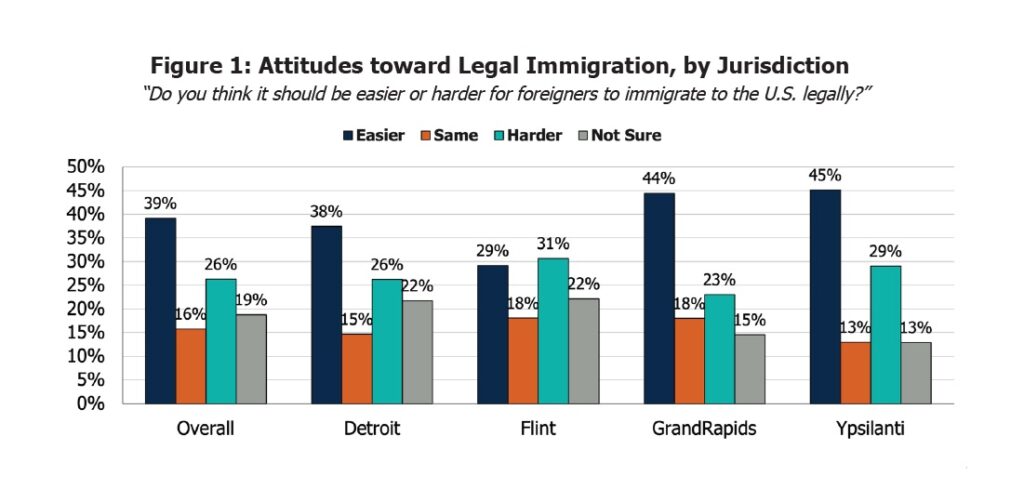
Ypsilanti residents (45%) and Grand Rapids residents (44%) were more likely than residents of Detroit (37%) and Flint (29%) to favor making legal immigration easier. On the other end of the spectrum, 31% of Flint residents, 29% of Ypsilanti residents, 26% of Detroit residents and 23% of Grand Rapids residents said it should be more difficult for foreigners to immigrate to the U.S. legally.
“The entire state of Michigan is considered a border zone because of its proximity to Canada, and immigration is a factor in how elected officials and community leaders have sought to reinvigorate local economies. Understanding how Michiganders think about immigration can inform policy discussions going forward,” said Yucheng Fan, data manager at the Detroit Metro Area Communities Study.
A new brief, “How Michiganders are Thinking about Immigration,” examines trends in attitudes about immigration based on people’s educational attainment and their proximity to foreign-born residents. The work was supported by the Knight Foundation, Ballmer Group, Kresge Foundation, U-M’s Poverty Solutions and Michigan CEAL.
Overall, 55% of residents with a bachelor’s degree living in Detroit, Flint, Grand Rapids and Ypsilanti supported making it easier for foreigners to immigrate to the U.S. legally, compared to only 34% of residents of these cities who did not have a bachelor’s degree. Residents who did not have a bachelor’s degree (29%) were more likely than residents with a bachelor’s degree (18%) to believe it should be harder for foreigners to immigrate to the U.S. legally.
However, residents of these cities without a bachelor’s degree (21%) were also more likely than residents with a bachelor’s degree (12%) to say that they were not sure of their views on U.S. immigration policy. Residents with and without a college degree were equally as likely to say immigration policy should remain the same.
“The surveys also found U.S.-born residents living in neighborhoods with more immigrants tend to have more favorable attitudes toward immigration. This is consistent with past research, and it shows that people who likely have more sustained contact with immigrants have a more positive view of immigration,” said Mara Ostfeld, a faculty lead at the Detroit Metro Area Communities Study.
On average, for every 10 percentage-point increase in the share of a census tract’s population that is foreign-born, there is a roughly three percentage-point increase in the degree to which U.S.-born residents support making it easier for immigrants to enter the country legally.
Child care workers caught in middle of Michigan’s broken child care system
Sadie Riley-Flemming, director of Blackbird Child Care Center in Harbor Springs, greets a girl on April 19, 2024. Photos by Molly Hauxwell Currier for the University of Michigan.
By Lauren Slagter
U-M Poverty Solutions
A teacher has a question, notes for families await delivery to classrooms, and a little girl arriving at Blackbird Child Care Center in Harbor Springs needs her rain boots swapped for shoes.
Sadie Riley-Flemming responds to it all with a smile.
“Are you leaving your unicorn in your cubby or are you taking it to your classroom?” Riley-Flemming asks the girl, kneeling beside her in the hallway lined with colorful kids’ artwork. “You can’t forget your water bottle. Let’s grab your lunch box.”
Riley-Flemming walks the girl down the hall and continues her morning rounds, popping between classrooms for infants up to 12 year olds. A cuddly toddler’s drool soaks into Riley-Flemming’s gray Blackbird sweatshirt as she greets kids with hugs and plays with them briefly while asking their teachers if they need anything. In one room, Riley-Flemming’s son offers her a tray of plastic food.
“Mommy, I got all the food on there for you,” he says.
All morning, Riley-Flemming shifts between her role as a mother to two kids under 5, director of Blackbird Child Care Center, and frontline child care worker. She has a unique vantage point on Michigan’s child care industry – and lately she finds it “overwhelming and heartbreaking.”
“I could cry right now because it’s so tough,” says Riley-Flemming, 26, who has eight years of experience working in child care. “How can we provide families with affordable, quality child care without breaking their bank, but also give our employees a living wage? There’s just so many aspects of it. And there’s not a good answer right now.”
That gap Riley-Flemming identifies between what parents can afford to pay and the cost of quality child care is one of the key drivers of Michigan’s undersized child care workforce and shortage of available child care, according to research from North Central Michigan College’s Child Care Initiative and the University of Michigan’s Poverty Solutions.

Sadie Riley-Flemming plays with kids at Blackbird Child Care Center in Harbor Springs on April 19, 2024.
Statewide, there are about four children under 12 for every available child care spot. A couple making Michigan’s median income will spend about 14% of their income on center-based care for an infant – double the 7% of household income considered affordable for child care by the U.S. Department of Health and Human Services.
NCMC’s Child Care Initiative began working with Poverty Solutions in 2021 to better understand child care needs in Emmet County, located along the Lake Michigan shoreline at the northern tip of Michigan’s mitten. Historically, child care has been an undervalued industry, but the pandemic – with its temporary closures of child care facilities – made clear just how essential these workers are. With the workforce still in flux post-pandemic, Michigan misses out on $2.88 billion annually in economic activity when working parents struggle to find child care, according to a report from the Michigan Chamber of Commerce.
“Families and employers rely on child care providers to make our workforce work, so we need to solve this puzzle of how to sustainably fund quality child care,” said Jennifer Wixson, coordinator of early childhood education at NCMC.
Jennifer Wixson
As child care providers, parents, policymakers, and researchers wrestle with how to address Michigan’s child care shortage and make the business model work, Riley-Flemming sees child care workers – many of whom are parents too – getting caught in the middle.
Child care often takes up a large portion of a parent’s earnings, Riley-Flemming noted, even if child care workers get discounted tuition for their kids’ care.
“Then they’re also still not being paid a livable wage,” she said. “So they’re stuck in this middle ground where they might love working in the field, but they’re not really getting ahead, are they?”
High tuition, low worker pay

View of Little Traverse Bay from Harbor Springs. Photo by Lauren Slagter
Blackbird Child Care Center occupies one wing of Blackbird Elementary School, a brick building tucked in the trees half a mile from Harbor Springs’ panoramic views of Little Traverse Bay. Multi-million-dollar houses perch on the bluff overlooking the downtown district that serves tourists as well as the 1,270 residents that make up the close-knit community.
Across the bay from Harbor Springs sits Petoskey, a city of 5,670 people that is the metropolitan center of rural Emmet County. Like other tourist destinations, Petoskey is torn between catering to vacationers seeking second homes with bay views and remaining affordable for hospitality, retail, and health care workers who make the community run. For those workers to work, they need child care.
Blackbird is one of the more expensive child care centers in the area, Riley-Flemming said, as well as one of the higher-paying for employees. The pay still isn’t enough for workers to comfortably afford the local cost of living.
Most of the Emmet County child care employees surveyed by NCMC’s Child Care Initiative said they earn less than $50,000 a year, and pay for assistant teachers starts at $13 per hour. Across the state, early childhood educators earn 21.5% less than colleagues in the K-8 system and are 7.3 times more likely to live in poverty than Michigan K-8 teachers.
“I feel like the child care teachers who are here deserve a lot more than what they get,” said Riley-Flemming, who has been director of Blackbird Child Care Center since 2021. “And it’s been a challenge trying to find a way to give them what they deserve and continue to be operational financially.”

Teacher bios and notes of appreciation hang in the hallway at Blackbird Child Care Center in Harbor Springs.
Market demand would justify raising child care rates. With a shortage of available child care workers, more than 40% of Michiganders live in areas considered “child care deserts,” and the areas with the least child care availability are often rural and concentrated in northern Michigan. Blackbird closed its waitlist after it reached 240 kids, and Riley-Flemming said other local child care providers also have waitlists.
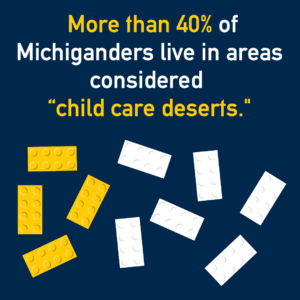
About 9% of Emmet County’s 34,100 residents live in poverty, compared to 13.4% of all Michigan residents. While Emmet County’s poverty rate is lower than the state overall, Riley-Flemming said many of the 136 kids at Blackbird Child Care Center are from working-class families from Petoskey, Harbor Springs, and the nearby village of Alanson. Raising tuition would only price them out.
Even with the discounted tuition she receives for working at Blackbird, Riley-Flemming and her husband, who works as a carpenter, can barely afford to send their two children there. To help lower costs, Riley-Flemming’s mother watches the kids one day a week. In months when money is tight, Riley-Flemming asks family members to take the kids more often.
“It’s a financial pressure to have them (in child care) more days a week,” Riley-Flemming said.
The average cost for infant care in a licensed child care center in Michigan is $13,620 annually. Regulations requiring small ratios of children to staff ensure kids have adequate supervision and also raise the cost of doing business.

William Lopez
In order for a family to spend no more than 7% of their income on child care while enrolling one infant in full-time care, their annual income would need to be $194,571. Michigan’s median household income is $68,505.
“The relationships between child care, income, and well-being are well documented in research and felt every day in households throughout Michigan. Parents need reliable, safe child care to be able to work consistently and provide financial stability to their families. Inconsistent child care – which can result in inconsistent work or job loss – can make it difficulty to buy groceries, pay rent, or afford the everyday household needs,” said William Lopez, a clinical assistant of public health at U-M and special advisor at U-M’s Poverty Solutions, who has studied child care needs across Michigan.
A call for more public investment in child care
Riley-Flemming has tried everything she can think of to make the math work for her child care center and the families it serves, including her own. She has applied for grants, worked with local organizations to fund tuition scholarships, and offered employees flexible scheduling to give them better work-life balance in lieu of higher pay. Frequent scheduling changes mean Riley-Flemming and Blackbird’s assistant director often cover classroom shifts, which draws them away from their administrative duties.
None of Riley-Flemming’s efforts have generated the revenue needed to adequately pay child care workers while keeping quality care affordable for families. The answer, she suggested, requires effort at the governmental level.
“Schools are subsidized. That’s (public) education. Early childhood programs are also education. So I feel like it’s not a far stretch to say that the government should also look into supporting child care programs,” Riley-Flemming said.
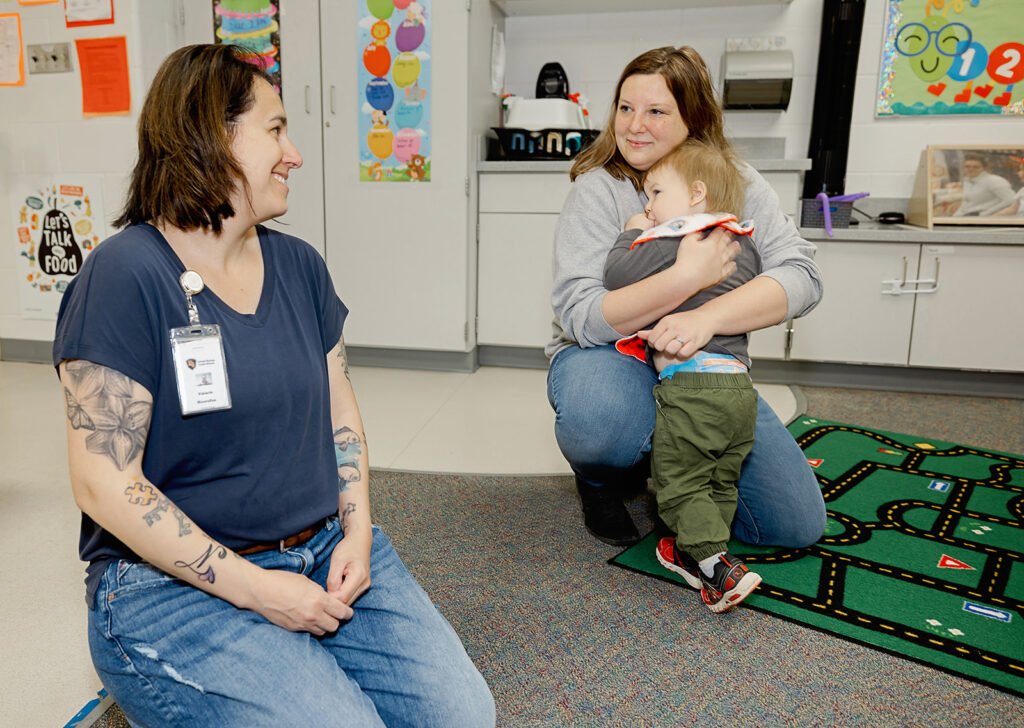
Sadie Riley-Flemming (right) talks with a staff member at Blackbird Child Care Center in Harbor Springs on April 19, 2024.
Federal and state funds support the Great Start Readiness Program, Head Start, and Early Head Start, which offer free child care and preschool for 3 and 4 year olds from families with low incomes. However, these programs are oversubscribed and not available in every community. Gov. Gretchen Whitmer has set a goal of providing free pre-Kindergarten for every 4 year old by 2027. While a necessary first step, even universal preschool would leave working parents in need of child care for their younger kids and for older kids outside of school hours.
Michigan’s Child Development and Care (CDC) subsidy promises more flexibility in helping families pay for child care, while reliably delivering payments to child care providers. In 2022, Michigan expanded the income eligibility for CDC subsidies, making up to 105,000 additional children eligible for the subsidy. However, only about 10% of children aged 0 to 11 years in households with incomes below the new eligibility threshold receive the subsidies.
“The low utilization rate of the Child Development and Care subsidy raises questions about barriers to accessing it and whether it’s meeting families’ needs when they receive it,” said Karen Ann Kling, assistant director of policy and impact at U-M’s Poverty Solutions.
Karen Kling
Kling co-authored a policy brief on challenges and opportunities related to the CDC subsidy, drawing from interviews with 41 parents of young children and child care professionals in southeast Michigan and Emmet County.
The interviews revealed numerous reasons parents do not apply for the child care subsidy: extensive paperwork requirements, language barriers, distrust of the government, and a reliance on internet-based applications. There’s also the “catch-22” that people need employment to qualify for the CDC subsidy, but it’s difficult for parents to find employment without child care.
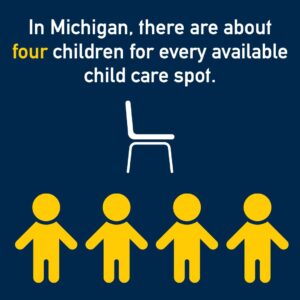 Parents who do receive the subsidy then have to find a child care provider approved to accept subsidies that has space for the child and offers care in a location and at hours that work for the family – no easy task with four young kids for every available child care spot in Michigan. This combination of barriers explains why Michigan’s child care subsidies are underutilized, Kling said.
Parents who do receive the subsidy then have to find a child care provider approved to accept subsidies that has space for the child and offers care in a location and at hours that work for the family – no easy task with four young kids for every available child care spot in Michigan. This combination of barriers explains why Michigan’s child care subsidies are underutilized, Kling said.
Riley-Flemming also has seen various factors prevent families from using the child care subsidy. She recalled one parent who lost her other public benefits after being approved for the CDC subsidy because of an administrative error in the application process. Another parent declined to apply for the subsidy because she didn’t want to give her children more vaccines to meet state regulations, Riley-Flemming said, and didn’t know there’s an option to submit a vaccine waiver. Blackbird employees with kids at the center could not receive the subsidy if they worked in the same classroom where their kids spent the day.
Still, Blackbird has a handful of families who use the child care subsidy, and Riley-Flemming said it’s a fairly easy process to accept the payments every month. And it isn’t only families that benefit from the subsidy. Riley-Flemming finds the subsidy payments are a more reliable source of revenue than income from families struggling to make payments.
Rethinking Michigan’s child care subsidy system
For Michigan’s child care subsidy to realize its goal of providing access to affordable, high-quality child care, Riley-Flemming would like to see the state raise the income cutoff. Currently, households making 200% of the federal poverty line or less are eligible for the subsidy, which equates to $51,640 a year for a family of three in 2024.
The Tri-Share program – which splits the cost of child care among the parent, their employer, and the state – is available to people who make too much to qualify for the subsidy, up to 325% of the federal poverty line. Employers benefit when their employees can focus on work without child care concerns, and having employers contribute to child care costs eases the burden on families and limited government funds. The Tri-Share website lists only 186 participating employers across the state.

Sadie Riley-Flemming leads kids down the hall at Blackbird Child Care Center in Harbor Springs on April 19, 2024.
“I think our working-class families are at a large disadvantage where they can’t get ahead,” Riley-Flemming said. “We all want what’s best for the kids and the families and that’s to move forward with life and not be so stuck or living paycheck-to-paycheck. I think lifting that threshold (for child care subsidies) will help a lot of families be more successful.”
But making more families eligible for assistance to pay for child care only helps if enough child care spots are available.
“Growing the child care workforce is an essential part of solving Michigan’s child care crisis. We need to address availability as well as cost,” said Amanda Nothaft, director of data and evaluation at U-M’s Poverty Solutions, who co-authored the child care subsidy policy brief with Kling and Lopez.
Amanda Nothaft
Researchers at U-M’s Poverty Solutions also recommend reducing the amount of paperwork needed to apply for and maintain the child care subsidy, for both parents and child care providers. To help answer child care providers’ frequently asked questions about the CDC subsidy, Poverty Solutions worked with the Michigan Department of Health and Human Services in 2022 to create a website with clear information on the steps needed to accept the subsidy.
NCMC’s Child Care Initiative is testing a “true cost” model in an Emmet County child care business that will include standard costs such as licensing, facilities, and non-personnel items as well as living wages and benefits for all staff and owners, plus the cost of quality programming, professional development, and employee wage increases.
“Charging the true cost of child care makes the child care industry sustainable in the long run and will grow the supply of child care in our area,” Wixson said. “As part of the true cost model, we’re also working to secure various public and private funding streams, so we have a blueprint for how to cover the cost without pricing out families.”
In the meantime, Riley-Flemming feels stretched between wanting to do right by Blackbird families as well as employees. She tries to stay focused on the kids that fuel her passion for the work.
“Early childhood is the foundation to education,” Riley-Flemming said. “So you start building … that early learning to help children be more successful as they go through the school system. You invest in children, you’re investing in your future.”
Related
The Child Development and Care Subsidy: Challenges and Opportunities policy brief
North Central Michigan College Child Care Initiative
The Updated Michigan Child Development and Care Subsidy: What Child Care Providers Need to Know
Want more news on economic mobility issues across Michigan? Sign up for the University of Michigan’s Poverty Solutions newsletter.
U-M study: Detroit’s Black homeowners gained nearly $3B in real estate wealth from 2014-22
University of Michigan Professor Jeffrey Morenoff (left) stands with Detroit Mayor Mike Duggan (center) and other speakers at a press conference on April 16, 2024, about Morenoff’s findings on how Detroit home values changed from 2014 to 2022. (Photo courtesy of City of Detroit)
Release from the City of Detroit
DETROIT – Today, Mayor Mike Duggan and City Council members joined with Detroit residents and real estate agents to celebrate a major milestone for Detroit’s Black homeowners: nearly $3 billion in added home wealth since 2014 for those who stayed in the city.
A comprehensive new study released today by the University of Michigan’s Poverty Solutions concluded that Black homeowner-occupants in Detroit amassed $2.8 billion in added home value between 2014 and 2022, which represents an 80% increase during that time. The study analyzed changes in Detroit’s housing values for the nine-year period following the city’s municipal bankruptcy to understand how much growth there has been and whether that growth has been equitably distributed across neighborhoods and racial/ethnic populations.
The study was led by Jeffrey D. Morenoff, who is a professor and associate dean at the Gerald R. Ford School of Public Policy and professor in the Department of Sociology and Population Studies Center at the University of Michigan. Demographer and Founder of Data Driven Detroit Kurt Metzger and City of Detroit Financial Analyst Christina Shaw co-authored the report.
According to the study’s findings, the net value of all owner-occupied homes increased from $4.2 billion in 2014 to $8.1 billion in 2022, a $3.9 billion/94% increase in housing wealth over these nine years. It also estimates Black homeowners realized the vast majority of that gain in wealth, with their home values rising from $3.4 billion in 2014 to $6.2 billion in 2022, a $2.8 billion jump.
“For the past nine years, the active members of 600 organized block clubs and neighborhood associations in the city have been working to rebuild their neighborhoods. The $3 billion in new home wealth they have created and earned is a direct result of their dedication and hard work,” said Mayor Mike Duggan.
Ken Scott, past president of the Greater Detroit Realtist Association and Detroit Association of Realtors and a HUD certified housing counselor, said the study matches what he and his fellow realtors have been seeing over the past several years.
“There has been a huge shift for the better in Detroit’s home values, driven largely by the improvements being made in neighborhoods. My fellow realtors and I have been seeing this shift for years. Black-owned homes are rising in value and Black families are gaining the most family wealth,” said Scott. “And while home values have risen dramatically, there is a lot of growth yet to come. Detroit homes are beautiful and dollar-for-dollar still a great value.”
Scott also praised programs that create new homeowners, like Detroit’s Down Payment Assistance Program, which was funded by the American Rescue Plan Act and provides grants of up to $25,000 to help with closing costs and other costs associated with home purchases to make homeownership more accessible and affordable. So far, the program has created nearly 500 new homeowners in Detroit – most of them Black. A second round of the program is expected to open in June.
Lowest value areas saw greatest increase
The U-M study shows that neighborhoods that were at their lowest point in 2014 have risen the most in value. Neighborhoods that had the lowest values in 2014 saw a nearly 300% increase in value in 2022, while those areas of comparatively middle and high value saw increases of 99% and 131%, respectively.
“Home values grew the most from 2014 to 2022 in neighborhoods with the lowest property values and highest poverty rates in 2014,” the study says. “Neighborhoods with high concentrations of Hispanic/Latino populations, especially those in Southwest Detroit, experienced some of the largest increases in home values over the nine-year time period. The growth in home values was geographically dispersed in neighborhoods throughout the city rather than being concentrated in neighborhoods in the downtown and midtown areas.”
In the Condon neighborhood, which saw one of the largest rises in value, the average home sale price in 2014 was about $7,500. By 2022, the average home sale had soared to more than $71,000 – an increase of 853%. Other neighborhoods in the city, including Jefferson/Mack, Kettering, Springwells and Davison, saw increases of 300% or more.
The mayor attributed the neighborhood rebound to committed residents who fought for their communities and did the hard work to keep them stable as the city worked to recover. He also credited city employees for a series of neighborhood improvements that have contributed significantly to rising home values, including:
- Renovation of more than 170 city parks and recreation centers
- Removal of 25,000 dangerous vacant homes
- Renovation and re-occupancy of 15,000 salvageable vacant homes
- Sale of 25,000 vacant side lots to adjacent homeowners
- Cleaning of 3,000 overgrown and trash-filled alleys
- Commercial blight removal and corridor cleanup
- New neighborhood streetscapes bringing back small businesses
- 167 new Motor City Match businesses open across the city
- Safer neighborhood streets thanks to installation of 10,000 speed humps
- Programs like Renew Detroit, 0% Interest Home Improvement Loan Program to address critical repairs and to help keep longtime Detroiters in their homes.
The study also cited the dramatic reduction in tax foreclosures in Detroit as a key factor in determining the net wealth gain. Since 2016, the city and a coalition of partners has helped to reduce tax foreclosures by 95%, also helping to keep thousands more longtime Detroiters in possession of their homes. Those partners have included:
- The Rocket Community Fund
- Gilbert Family Foundation
- U-SNAP-BAC
- Eastside Community Network
- Bailey Park
- Hannan Center
- Central Detroit Christian
- Cody Rouge Community Action Alliance
- Bridging Communities
- MiWealth
- United Community Housing Coalition
- Wayne Metro
- Accounting Aid Society
Payments begin for 100 low-income entrepreneurs in Guaranteed Income to Grow Ann Arbor pilot
Poverty Solutions Associate Faculty Director Kristin Seefeldt (left) and Graduate Student Research Assistant Emily Shupp Parker (center) share information on Guaranteed Income to Grow Ann Arbor at the Green Fair in downtown Ann Arbor on Sept. 22, 2023. (Lauren Slagter | Poverty Solutions)
Contact: Lauren Slagter, lslag@umich.edu
ANN ARBOR – One hundred Ann Arbor entrepreneurs, gig workers, and other independent workers with low incomes have received their first two guaranteed income payments of $528 as part of the Guaranteed Income to Grow Ann Arbor (GIG A2) pilot program. Payments started in January and will continue monthly through the end of 2025.
Poverty Solutions at the University of Michigan will evaluate the pilot program to determine whether the monthly payments:
- Positively contribute to participants’ social determinants of health, specifically through increased housing, food, and transportation security, improvements in physical and mental health and access to care, and improvements in access and quality of child care;
- Help small businesses and entrepreneurs stabilize and/or grow their businesses; and
- Allow entrepreneurs the time and resources to focus on their business.
Another 100 Ann Arbor entrepreneurs with low incomes who will not receive the monthly payments have been enrolled into the research group to support the research findings from this pilot.
“I’d like to give a special thanks to those participating in the research group, as they play a valuable role for us to compare outcomes between the two groups and draw more robust conclusions about the potential impact of receiving a guaranteed income payment as an entrepreneur,” said Kristin Seefeldt, the principal investigator for the research study, an associate professor of social work and public policy, and associate faculty director of U-M’s Poverty Solutions.
“The research findings will inform policymakers on the effectiveness of cash assistance programs and better ways to provide assistance for people who may need it,” Seefeldt added.
Funds for this pilot program come from the federal American Rescue Plan Act (ARPA) through the City of Ann Arbor and the Ann Arbor Area Community Foundation (AAACF).
“We are delighted this important program is up and running, and grateful for our partnership with the University of Michigan to make it happen,” said Mayor Christopher Taylor. “Guaranteed income is an idea whose time has come. I’m proud that Ann Arbor is able to support these individuals and their families and also work with researchers to answer important questions about the efficacy and impact of these programs.”
“We are inspired by the opportunity to join forces on this vital initiative, supporting entrepreneurs and small business owners in need,” said Shannon Polk, president and CEO of the Ann Arbor Area Community Foundation. “By leveraging the University of Michigan’s research data to provide guaranteed income, we are not only supporting families but also embracing the transformative impact of collaborative community partnerships.”
Additional support for this pilot program comes from Steady, the payment distributor; research assistants from U-M’s School of Social Work, Ford School of Public Policy, and School of Public Health; and many community organizations in Ann Arbor and at the state level.
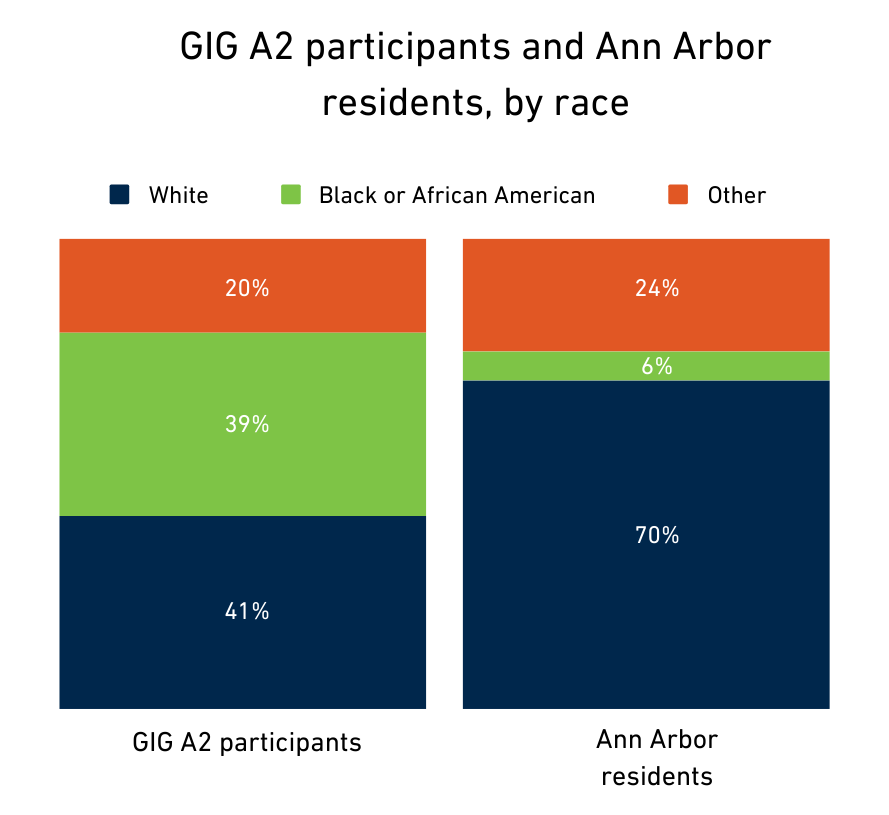
The chart shows the racial demographics of GIG A2 participants and Ann Arbor residents. Graphic by Dana Schau
The 200 GIG A2 participants are entrepreneurs, small business owners, and gig workers with low incomes who live in Ann Arbor. For this pilot, low income means within 225% of the federal poverty line, or $44,370 for a two-person household. GIG A2 participants were randomly selected to reflect the demographics of the eligible application pool of about 500 people. A demographic breakdown of eligible GIG A2 applicants is below:
- Race/Ethnicity: 41% of participants are White, 39% are Black, and 20% specified another race or ethnicity.
- Education: 55% of participants do not hold a bachelor’s degree, 45% hold a bachelor’s degree or higher.
- Type of Work: 60% of participants do not use a platform or app for their entrepreneurial work, 40% of participants use a platform or app like Uber, DoorDash, TaskRabbit, Fiverr, or YouTube. GIG A2 participants work in the following sectors: food and events, arts and entertainment, personal and health care services, maintenance work, and a variety of other kinds of work.
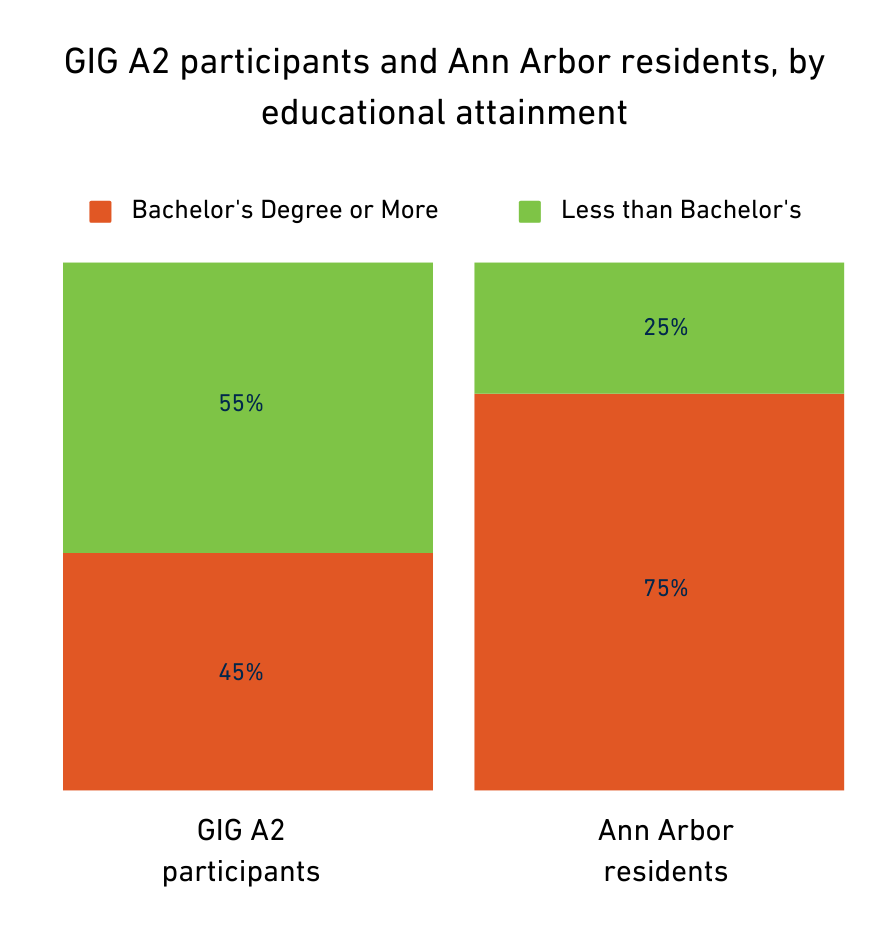
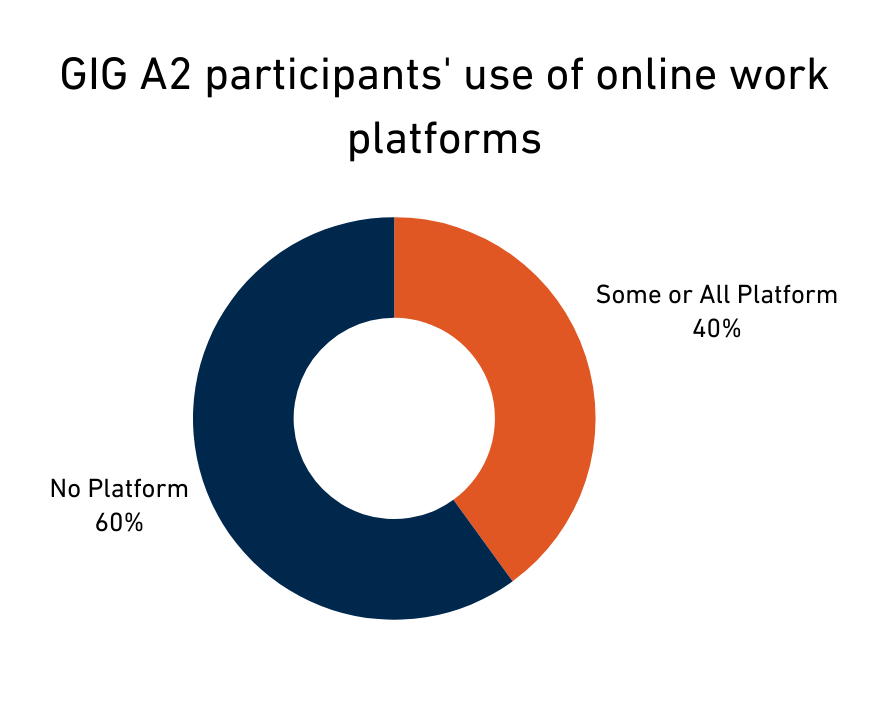 Over the next two years, GIG A2 participants will partake in surveys and interviews as part of the research study. GIG A2 participants who are not receiving the guaranteed income payments will be paid a small stipend, starting in March from funds contributed by AAACF, for participating in the research study until the end of 2025.
Over the next two years, GIG A2 participants will partake in surveys and interviews as part of the research study. GIG A2 participants who are not receiving the guaranteed income payments will be paid a small stipend, starting in March from funds contributed by AAACF, for participating in the research study until the end of 2025.
To receive a quarterly email newsletter with updates on GIG A2, please sign up here.
Press release written by Emily Shupp Parker
Detroit residents’ trust in police shaped by history of police contact
Contact: Lauren Slagter, lslag@umich.edu
DETROIT – Detroit residents who have had any type of contact with police are more critical of police than people who have no contact with police, according to a survey of Detroit residents from the University of Michigan.
U-M’s Detroit Metro Area Communities Study surveyed residents about their personal experiences with police in July 2020, shortly after George Floyd’s death at the hands of Minneapolis police officer Derek Chauvin. DMACS surveyed a representative sample of Detroit residents, and results have been weighted to reflect the population of the city of Detroit.
The survey asked about three types of interactions with police: forceful contact, nonforceful contact and no contact in the last year. Detroiters commented on their personal experiences as well as the experiences of their family and acquaintances, referred to as proximate contact. A new report analyzing the survey data found 37% of residents had personal or proximate contact with police.
Two percent of Detroit residents reported personal experiences with forceful police contact in the last year. Given Detroit’s total adult population estimate in 2020, this translates to about 8,755 adult residents experiencing forceful contact for the year. When including proximate contact, 17% of Detroiters either personally experienced or knew someone who experienced forceful police contact.
There are no significant racial differences among residents who experience personal or proximate forceful contact from the police, and there are no differences in experience of forceful police contact among Detroiters of different income levels, education levels and age cohorts. Women are less likely than men to report exposure to forceful police contact.
While any type of police contact correlated with more critical views of police, Detroiters who have had forceful contact with police tend to be even more critical of police than those with nonforceful contact.
Fifty-six percent of those who experienced forceful contact with police disagree that police are doing a good job protecting them and their neighborhood versus 33% of those with nonforceful contact and 22% of those with no police contact. Fifty percent of those with forceful contact disagree that police can be trusted in comparison to 27% of those with nonforceful contact and 19% of those with no contact.
“The similarities in views between residents who have experienced forceful and nonforceful contact with police suggests any type of contact with police may be enough to change people’s views on policing,” said Lauren Chojnacki, a research associate with DMACS who authored the report.
The survey analysis also found age is an important factor in determining Detroiters’ views toward police, especially among those who have experienced forceful contact. Detroiters aged 18-30 tend to hold more negative views toward the police than older Detroiters. Young Detroiters who experienced forceful police contact are more than twice as likely to disagree that the police are doing a good job in comparison to young Detroiters with no police contact (80% compared to 36%).
These survey findings add to a previous analysis of a DMACS survey on residents’ views on crime and policing conducted in summer 2021. That survey found 42% of residents said greater police presence in their neighborhood would make them feel safer, while 10% said more police in their neighborhood would make them feel less safe.
“There’s a simultaneous desire for police reform and favorable public opinion regarding police,” Chojnacki said “There’s a tension among residents who want both change in a system and the security and protection experienced within that system.”
Washtenaw County Prosecutor’s Office, ACLU of Michigan, University of Michigan announce release of Prosecutor Transparency Project study
Robust, Data-Driven Project Examines Racial Inequities in Prosecutorial System
Contacts: Liz Mack (Washtenaw Prosecutor’s Office), macke@washtenaw.org, 734-585-6714
Ann Mullen (ACLU of Michigan), amullen@aclumich.org, 313-400-8562
J.J. Prescott (U-M Law), jprescott@umich.edu, 734-763-2326
Trevor Bechtel (Poverty Solutions), betrevor@umich.edu, 734-615-0216
ANN ARBOR – Today, the Prosecutor Transparency Project released findings from a multi-year analysis of racial disparities in the prosecutorial system in Washtenaw County. The Prosecutor Transparency Project — a collaboration between the Washtenaw County Prosecutor’s Office, the ACLU of Michigan, the University of Michigan Law School, and the University of Michigan’s Poverty Solutions — seeks to analyze potential racial disparities in decisions made by the Washtenaw County Prosecutor’s Office.
A detailed summary of the findings is available at https://myumi.ch/23NQ4
As part of the Prosecutor Transparency Project, the Prosecutor’s Office gave independent researchers at the University of Michigan Law School complete access to its criminal case management systems, containing data from nearly 35,000 cases from 2017-2022. Those researchers analyzed the data to determine whether racial disparities exist at key prosecutorial decision-making points.
The Prosecutor Transparency Project represents the first time independent researchers have been provided access to extensive prosecutorial data in Michigan for the purpose of conducting a race-equity analysis. The Washtenaw County Prosecutor’s Office provided researchers from the University of Michigan unfettered access to felony and misdemeanor files, making the project one of the most comprehensive empirical studies on prosecutorial decision-making in the nation. The study also traverses two prosecutorial administrations, as Prosecuting Attorney Eli Savit took office in 2021.
The research team was led by Professor J.J. Prescott and Grady Bridges of the University of Michigan Law School. Prescott is one of the nation’s top empirical criminal justice scholars. Bridges has years of experience collecting and analyzing Michigan criminal justice data and served as data administrator for Michigan’s Criminal Justice Policy Commission.
Previous analyses—including the 2020 Citizens for Racial Equity in Washtenaw (CREW) report—have indicated that Black residents in Washtenaw County are disproportionately likely to face criminal charges. Although the Transparency Project focused specifically on prosecutorial decision-making (and did not purport to reach any conclusions about other systems actors), the University of Michigan’s analysis found that these numeric disparities are largely “baked in” by the time cases arrive at the Prosecutor’s Office.
Controlling for factors such as the severity of a case, the researchers also identified small disparities in certain prosecutorial decisions and no evidence of disparities in others.
Specifically, the study concluded:
- The prosecutor’s office was 0.7 percentage points more likely to authorize charges for defendants of color than for white defendants between 2017 and 2022. Though that disparity is marginally statistically significant, its statistical significance is driven by data from one year (2019).
- Defendants of color were charged with crimes having maximum sentences 2.15 months longer than white defendants in similar circumstances, with statistically significant disparities that were larger in 2018 and 2020.
- Among eligible defendants, people of color are less likely than white people to be designated as habitual offenders. A habitual offender designation means longer maximum sentences.
- Defendants of color faced 0.05 more charges per case on average than white defendants in similar circumstances between 2017 and 2022.
The study also looked for evidence of racial disparities in whether defendants are admitted into diversion programs — which allow a defendant to avoid a criminal record upon completion of a plan. The study found no evidence of racial disparities into whether similarly situated defendants are admitted into two programs: the Prosecutor’s pre-plea diversion program and the Holmes Youthful Trainee Act.
Finally, the study sought to identify potential racial disparities in plea bargaining decisions. Data limitations precluded the research team from reaching robust conclusions about plea-bargaining practices. However, its preliminary plea bargaining analysis did not find evidence of racial disparities.
“The Prosecutor and his team were always vigilant about protecting people’s privacy, but the office also made sure we had access to every bit of information we asked about that might be relevant to measuring disparities,” said J.J. Prescott, the Henry King Ransom Professor at the University of Michigan Law School. “Throughout the entire process, the Prosecutor has been eager for unvarnished answers so the office can continue to improve. PTP’s assessment in Washtenaw County provides a clear roadmap for conducting similar audits throughout Michigan and the nation.”
“The comprehensive nature of this study also puts Washtenaw County and Michigan more generally on the map in terms of evidence-based evaluation of prosecutorial decision making,” Prescott added. “Our analysis improves on other studies that have explored racial disparities in prosecutorial decision-making. Most existing work focuses on specific types or classes of cases, or suffers from significant data limitations that make it hard to pinpoint the sources of disparities. Our evaluation is not without weaknesses, of course, but we use the ‘blind spots’ in data collection and management that we uncover to shine a bright light on the need for critical data infrastructure improvements. For this reason, this collaborative effort takes an important step toward the goal of measuring, understanding, and working to eliminate disparities in prosecutorial decision-making.”
“Consequences in the criminal legal system should be imposed because of what someone did, not because of who they are,” said Washtenaw County Prosecuting Attorney Eli Savit. “I’m grateful to the research team for taking an unflinching look at potential racial disparities in prosecution. I am also grateful to the ACLU for funding this project, allowing this work to be completed without taxpayer expenditure. The data from this report will inform our continuing efforts to promote equal justice in our system.”
“The researchers’ independent report, for me, confirms my observations that our assistant prosecutors charging and resolving cases are doing so in a manner consistent with fairness and justice, not based on the color of someone’s skin,” said Washtenaw County Chief Assistant Prosecutor Victoria Burton-Harris. “As a leader of this office, that’s important to me. I’m proud to stand by it, and I look forward to continued efforts to ensure transparency and equity in our system.”
“A critical step in beginning to address the racial disparities in the criminal legal system is for agencies to track, analyze, and make publicly available data at every stage of the criminal legal process,” said Loren Khogali, executive director of the Michigan ACLU. “We commend the Washtenaw County Prosecutor’s Office for taking a look in the proverbial mirror and contributing to a growing body of data-driven studies, which also show how our criminal legal system has an inequitable impact on people of color, especially Black people. This report adds to the imperative that agency leaders throughout Michigan, including police chiefs, prosecutors, judges, and court administrators, also hold themselves accountable by examining their part in our deeply flawed criminal legal system.”
The Prosecutor Transparency Project’s full 116-page report is available for the public to read at
https://papers.ssrn.com/sol3/papers.cfm?abstract_id=4680695. In addition, to promote data accessibility, Poverty Solutions at the University of Michigan has published a digestible, interactive digital report outlining the key takeaways from the analysis, which is available at https://myumi.ch/23NQ4.
Dr. Trevor Bechtel — who has led multiple projects designed to increase access to information — spearheaded that effort.
“Working on the Prosecutor Transparency Project has allowed us at Poverty Solutions to bring our commitment to data and accessibility and transparency to work understanding the criminal legal system,” said Bechtel, the strategic projects manager of Poverty Solutions’ Washtenaw County programs. “We are excited to continue working with the Prosecutor Savit’s office as we move towards release of a data dashboard on prosecution in our county.”
Next steps for the Prosecutor Transparency Project include the identification of trackable metrics to ensure equitable treatment in the justice system and the creation of an interactive “data dashboard” for the Prosecutor’s Office. Results will continue to be made available as they are completed.
Poverty Solutions workshop generates novel solutions for addressing Michigan’s debt collection crisis
Participants gather at the Innovation Workshop 2024: Debt hosted by Poverty Solutions and held Jan. 27-28, 2024, at the U-M School of Information. Photo by Jose Juarez | Michigan Photography
Contact: Malcolm Phelan, 484-587-0094, mtphelan@umich.edu
ANN ARBOR – This past weekend at “Innovation Workshop 2024: Debt,” more than 50 lawyers, policymakers, students, and coders from around the country convened over two days to tackle the pressing issue of debt collection and its impact on Michigan’s families and legal system. Teams, led through a design-thinking framework, developed over 20 new approaches for reining in predatory debt collection, lessening the barrage of filings on local court systems, and providing information and resources to low-income Michiganders facing debt-related lawsuits.
Participants designed and prototyped ideas including an online “chat-bot” that would provide automated texts to defendants alerting them about critical court dates and offering referrals to legal aid organizations. Another concept was a computer application for court systems that could scan filings from debt collectors to ensure that the debt was legally owed. Many more concepts were designed and will continue to be explored by participants and participating organizations.

Participants gather at the Innovation Workshop 2024: Debt hosted by Poverty Solutions and held Jan. 27-28, 2024, at the U-M School of Information. Photo by Jose Juarez | Michigan Photography
Matt Andres, clinical professor of law at University of Michigan and chair of the Justice for All Commission Debt Collection Working Group, said: “Over 200,000 debt collection cases are filed in Michigan courts annually, and most of them result in a judgment for the creditor without a hearing ever taking place. Experts in Michigan and throughout the country have done some great work in the last few years on improving the fairness and legitimacy of how debt is collected through the courts. The Innovation Workshop brought many of those experts together in the same room with smart, creative students from a variety of disciplines in a well-structured problem-solving process. The out-of-the-box thinking the workshop encouraged yielded innovative ideas for products and policies that could be game changers for Michiganders facing the harsh consequences of debt.”
The event was hosted by U-M’s Poverty Solutions initiative. Trevor Bechtel, strategic projects manager at Poverty Solutions, said: “Poverty is a set of interlinking systems that don’t work for people facing economic insecurity. Debt can be one of the most challenging and pernicious barriers to prosperity, so we were delighted to see the ideas and energy generated by this event around this critical issue.”
Malcolm Phelan, the Michigan Law student who organized the event, said: “It was inspiring to see so many students and professionals excited to spend a full weekend working together to address the critical issue of debt collection in Michigan. The goal was to bring together practitioners who have spent decades working on these issues with coders, designers, and policy researchers who could bring new technologies and ideas to the effort. Based on the thoughtful and innovative solutions that were produced, the event was a resounding success.”

Participants gather at the Innovation Workshop 2024: Debt hosted by Poverty Solutions and held Jan. 27-28, 2024, at the U-M School of Information. Photo by Jose Juarez | Michigan Photography
The event was facilitated by Scott TenBrink, assistant director of civic engagement and lecturer at U-M’s School of Information, and Bridgette Carr, clinical professor of law at Michigan Law School. Presenters and participants included Justice Elizabeth Welch, former Chief Justice of the Michigan Supreme Court Bridget McCormack, Washtenaw County Prosecutor Eli Savit, state Sen. Jeff Irwin, as well as participants from national organizations such as the Aspen Institute, the Pew Foundation, the Legal Services Corporation, the American Arbitration Association, and the Princeton Debt Collection Lab. Michigan organizations included Detroit Justice Center, Michigan Poverty Law Program, and Legal Services of South Central Michigan. Student participants joined from U-M Schools of Law, Public Policy, Social Work, and Computer Science and Engineering as well as Michigan State University College of Law and Georgetown Law School. The event was sponsored by Michigan State University’s Center for Law, Technology & Innovation, the American Arbitration Association, and U-M’s School of Information.
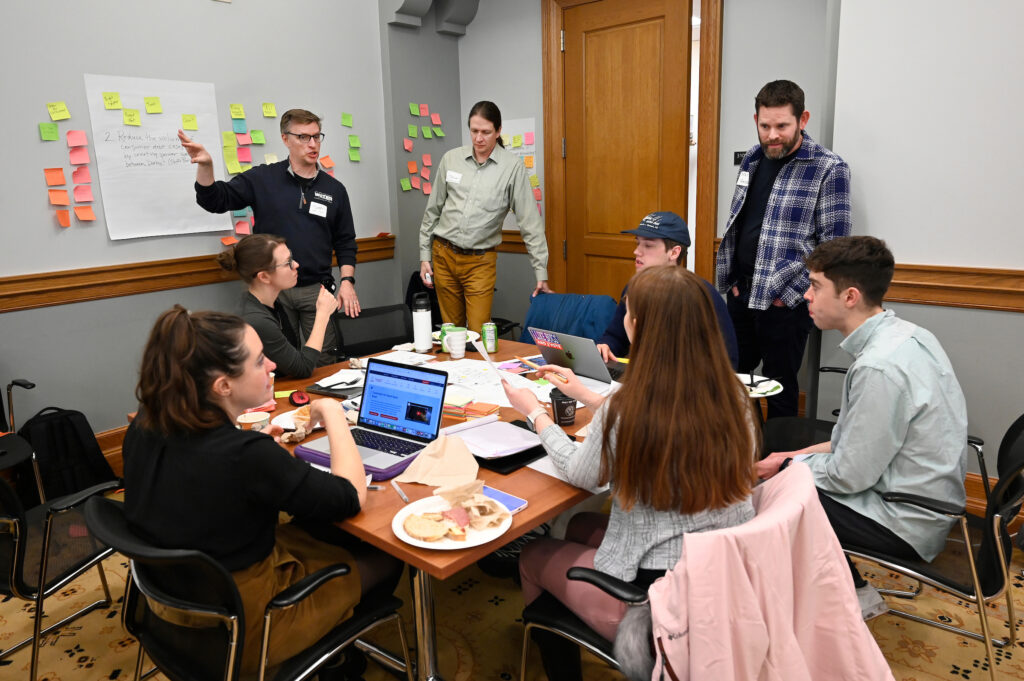
Participants gather at the Innovation Workshop 2024: Debt hosted by Poverty Solutions and held Jan. 27-28, 2024, at the U-M School of Information. Photo by Jose Juarez | Michigan Photography



